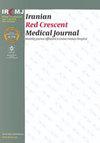Inhibition of Cancer Stem Cells Growth with Silibinin Encapsulated in Nanoparticles with Deregulation of miR-34a, miR-221, and miR-222
IF 0.2
4区 医学
Q3 MEDICINE, GENERAL & INTERNAL
引用次数: 0
Abstract
Background: Colorectal Cancer (CRC) is the most common malignant gastrointestinal cancer. Cancer stem cells (CSCs) are the major cause of cancer recurrence and cancer drug resistance. Silibinin, as an herbal compound, has anticancer properties. Objectives: The present study aimed to evaluate the antiproliferative effects of silibinin on HT29 stem-like cells (spheroids). Methods: In this study, antiproliferative and apoptotic properties of Silibinin encapsulated in Polymersome Nanoparticles (SPNs) were evaluated by MTT assay, propidium iodide (PI) /AnnexinV assay, cell cycle analysis, and DAPI (4',6-diamidino-2-phenylindole) staining. The expression of some miRNAs and their potential targets was evaluated by real-time reverse transcription-polymerase chain reaction (qRT-PCR). Results: IC50 of SPNs was determined at 28.13±0.78µg/ml after 24 h. SPNs (28µg/ml) induced apoptosis by 32.36% in HT29 cells after 24 h. DAPI staining indicated a decrease in stained nuclei after SPNs induction. SPNs treatment increased the expression of miR-34a, as well as P53, BAX, CASP9, CASP3, and CASP8. The downregulation of miR-221 and miR-222 was observed in SPNs treated cells. Moreover, SPNs decrease the expression level of CD markers in HT29 spheroids (cancer stem cells) compared to untreated spheroids. Spheroids were completely destroyed after 72 h treatment with SPNs (28µg/ml). Conclusion: As evidenced by the obtained results, SPNs can be used as an effective anticancer agent in multi-layer (cancer stem cells) and mono-layer cancerous cells with the upregulation of tumor suppressive miRs and genes, as well as downregulation of oncomiRs and oncogenes.解除miR-34a、miR-221和miR-222调控的纳米颗粒包封水飞蓟宾抑制癌症干细胞生长
背景:结直肠癌(Colorectal Cancer, CRC)是最常见的胃肠道恶性肿瘤。肿瘤干细胞(Cancer stem cells, CSCs)是肿瘤复发和耐药的主要原因。水飞蓟宾作为一种草药化合物,具有抗癌特性。目的:探讨水飞蓟宾素对HT29干细胞样细胞(球体)的抗增殖作用。方法:采用MTT法、碘化丙啶(PI) /AnnexinV法、细胞周期法和DAPI(4′,6-二氨基-2-苯基吲哚)染色,观察聚合体纳米颗粒(Polymersome Nanoparticles, SPNs)包封水飞蓟宾的抗增殖和凋亡特性。通过实时逆转录聚合酶链反应(qRT-PCR)评估部分mirna及其潜在靶点的表达。结果:24 h后SPNs的IC50为28.13±0.78µg/ml, SPNs(28µg/ml)诱导HT29细胞凋亡率为32.36%,DAPI染色显示SPNs诱导后染色细胞核减少。SPNs处理增加了miR-34a以及P53、BAX、CASP9、CASP3和CASP8的表达。在spn处理的细胞中观察到miR-221和miR-222的下调。此外,与未处理的球状体相比,SPNs降低了HT29球状体(癌症干细胞)中CD标志物的表达水平。SPNs(28µg/ml)处理72 h后,球体被完全破坏。结论:spn可作为多层(肿瘤干细胞)和单层癌细胞的有效抗癌药物,其抑瘤miRs和抑瘤基因上调,癌因子和癌基因下调。
本文章由计算机程序翻译,如有差异,请以英文原文为准。
求助全文
约1分钟内获得全文
求助全文
来源期刊

Iranian Red Crescent Medical Journal
MEDICINE, GENERAL & INTERNAL-
CiteScore
1.16
自引率
0.00%
发文量
0
期刊介绍:
The IRANIAN RED CRESCENT MEDICAL JOURNAL is an international, English language, peer-reviewed journal dealing with general Medicine and Surgery, Disaster Medicine and Health Policy. It is an official Journal of the Iranian Hospital Dubai and is published monthly. The Iranian Red Crescent Medical Journal aims at publishing the high quality materials, both clinical and scientific, on all aspects of Medicine and Surgery
 求助内容:
求助内容: 应助结果提醒方式:
应助结果提醒方式:


